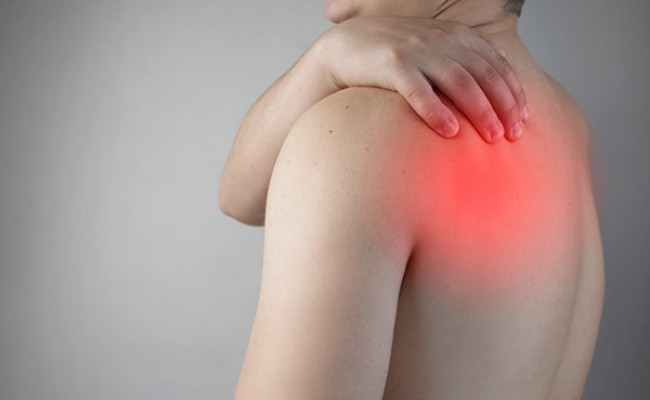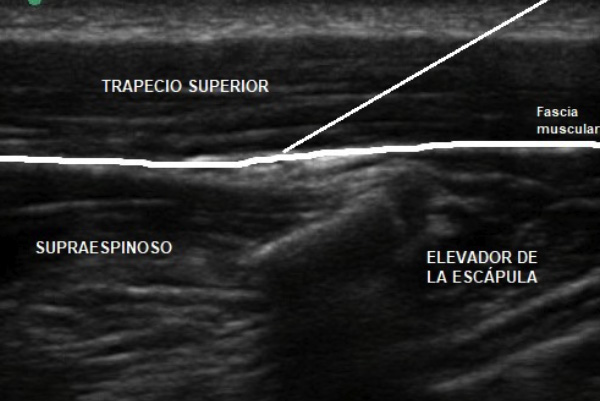
Ultrasound-guided interfascial infiltration of the upper trapezius and levator scapulae
- 17/02/2023
What is Ultrasound-Guided Interfascial Infiltration of the Upper Trapezius and Levator Scapulae? [VIDEO]
Ultrasound-Guided Interfascial Injection of the Upper Trapezius and Levator Scapulae
Ultrasound-guided interfascial injection of the upper trapezius and levator scapulae muscles is an interventional procedure that uses ultrasound guidance to place analgesic and anti-inflammatory medication between the fascia of both muscles.
Both muscles are commonly affected by chronic pain, whether due to postural causes, overload, overuse, repetitive movements, physical exertion, or myofascial injury.
Ultrasound-guided injections at the interfascial level aim to provide analgesia to the muscle groups causing acute or chronic pain. Fascia is the connective tissue that surrounds and separates muscles. Nerves and blood vessels circulate through it. Ultrasound guidance allows us to deliver medication (usually local anesthetics and corticosteroids) with extreme precision, minimizing the risk of injury to neurovascular structures.
What are the indications for interfascial ultrasound-guided injections of the upper trapezius and levator scapulae muscles?
The indications for interfascial ultrasound-guided injections are reserved for a second line of treatment, when physical therapy and rehabilitation cannot control the pain. Interfascial ultrasound-guided injections are indicated for:
- Chronic myofascial pain: When muscle pain is persistent and has not improved with other treatments, such as physical therapy or oral medication. This pain may be associated with the presence of trigger points.
- Trigger points: These are hypersensitive areas in the muscle that can cause referred pain to other parts of the body. The injection seeks to inactivate these points.
- Limited function: If pain in these muscles causes a reduction in mobility or function of the shoulder, neck, or scapula.
- Levator scapulae syndrome: A specific condition characterized by pain and stiffness in the neck and shoulder due to tightness of the levator scapulae muscle.
The upper trapezius is the most important stabilizer of the scapula. Its involvement, in the form of overactivity, stiffness, overload, or fatigue, can lead to altered scapular muscle balance, resulting in erratic scapular mobility, a common source of shoulder and cervical pain.
The levator scapulae is a stabilizing muscle of the superomedial angle of the scapula, which contributes to scapular elevation.
Both muscles are common sources of acute and chronic pain in daily clinical practice.
What is the procedure for ultrasound-guided interfascial infiltration of the upper trapezius and levator scapulae?
The ultrasound-guided interfascial injection procedure of the upper trapezius and levator scapulae muscles is usually performed in an outpatient setting and takes 10 to 15 minutes. Here is a summary of the procedure:
- Preparation: An ultrasound is performed prior to injection, with anatomical structures identified and skin markings of the entry points.
- Local anesthesia: A small amount of local anesthesia may be applied to the skin to reduce pain during the injection.
- Asepsis: The skin is cleansed with antiseptic, and the equipment and drape are prepared under strict aseptic conditions.
- Ultrasound guidance: Ultrasound is used to guide the needle into the interfascial space of both muscles and ensure the medication is administered in the correct location.
- Drug injection: The medication is administered through the needle, and we observe how it diffuses between both fasciae.
Patients who fail to improve with various rehabilitation treatments are candidates for interfascial ultrasound-guided injections.


Book an appointment with Dr. Jordi Jiménez. He will see you at the center of Palma de Mallorca and help you regain your quality of life.

![[VIDEO] Ultrasound-Guided Injection for Trigger Finger](https://drjordijimenez.com/imagen/100/100/Imagenes/infiltracion-ecoguidada-dedo-resorte-drjordijimenez.jpg)
![[VIDEO] Ultrasound-guided infiltration of the lumbar facets](https://drjordijimenez.com/imagen/100/100/imagenes-pagina/sindrome-facetario-lumbar-drjordijimenez (1).jpg)
![[VIDEO] Ultrasound-guided infiltration of the hip joint](https://drjordijimenez.com/imagen/100/100/Imagenes/valgo-dinamico-rodilla-drjordijimenez.jpg)